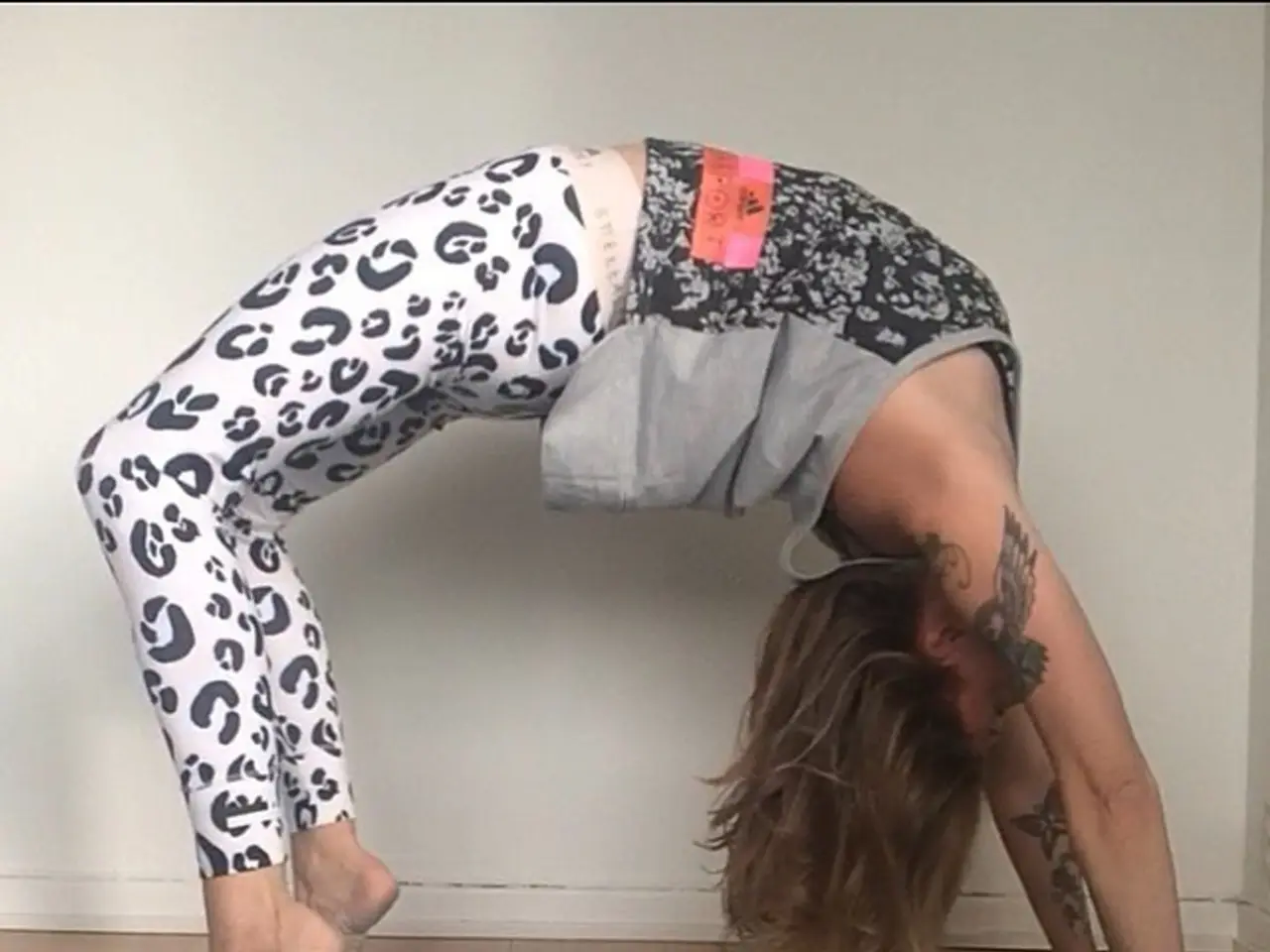6 Yoga Poses to Aid Prostate Expansion
Yoga has been identified as a potential complementary approach in managing the symptoms of Benign Prostatic Hyperplasia (BPH), a common condition affecting middle-aged and older men. BPH is an enlargement of the prostate gland, a small gland about the size of a walnut that is part of a man's reproductive system.
Men with BPH may experience difficulty starting and stopping urination, a weak urine stream, frequent urination, and the need to urinate again soon after. To alleviate these symptoms, yoga poses such as the Cobbler Pose (Baddha Konasana) and Hero Pose (Virasana) have been associated with symptom relief and improved quality of life.
The Cobbler Pose is a seated position that involves bending the knees to the side, placing the soles of the feet together, holding the hands clasped around the feet, lowering the knees as far to the ground as possible, and then breathing deeply and relaxing the pose. This pose is believed to help release pelvic tension, improve bladder control, and reduce stress.
The Hero Pose (Virasana) is another seated position that can help release pelvic tension around the prostate. To do the Hero Pose, an individual should kneel down, lower their bottom to the floor, sit between their feet with knees to the floor and feet pointing to the back of the room, rest their hands on the thighs with palms down, keep the weight between the hips, try not to put too much pressure on the knees, sit as straight upright as possible, breathe deeply and relax the pose.
Yoga may help improve the symptoms of BPH by exercising and strengthening the muscles in the pelvic floor. To try Kegels, a person should imagine squeezing in the pelvic floor muscles, as if they are trying to stop urinating, keep them squeezed for a couple of seconds and then release, repeat these 3 to 12 times.
A study showed that exercise could help reduce the risk of BPH, and doing exercise such as yoga may be helpful in preventing the condition. While yoga is not a standalone cure for BPH, it can be a valuable adjunct therapy that potentially improves symptoms like urinary discomfort and quality of life by addressing physical, hormonal, and stress-related factors involved in prostate health.
It's worth noting that some yoga poses can be challenging for beginners. For instance, the Head-to-Knee Pose (Janusirsasana) is a seated forward bend pose that focuses on stretching one leg and may help improve strength in the core region. To do the seated Head-to-Knee Pose, a person should sit on the floor with both legs extended in front of them, bend their right knee to the side, so that the sole of their right foot rests against their inner thigh, keep their weight over the left leg, slowly walk their hands out in front of them, reach forwards to hold their foot, lean forward from the hips and look forward to their toe, tuck their chin in and bend their head forward and down to rest on their shin, breathe deeply into the position to release tension, slowly return to an upright position, release both legs, and repeat on the other side.
For those who find the Hero Pose difficult, using a cushion can provide added support. Similarly, sitting on a cushion can make the Cobbler Pose easier. As with other seated poses, sitting on a cushion can provide added support if a person finds the seated Head-to-Knee Pose difficult.
In addition to the Cobbler Pose and Hero Pose, the Reclining Big Toe Pose (Supta Padangusthasana) is a lying-down, leg extension pose that may strengthen the pelvic floor and release tension. To do the Reclining Big Toe Pose, a person should lie on their back with both legs extended, bend their left knee, pull their thigh to their chest, keep their right leg pressed into the floor with the foot flexed, toes pointing upward, hold on to their toes on their left foot or put a strap around the foot if they are less flexible, straighten the left leg as far as possible, with sole flexed up towards the ceiling, breathe deeply into the position.
For a more advanced position, the Bow Pose (Dhanurasana) is a lying-down back bending pose that may strengthen the abdomen, pelvic floor, and lower back. To do Bow Pose, a person should lay on their stomach with their arms at either side, lift their heels up towards their bottom, bending their knees, reaching back with palms facing upwards, grasp hold of each ankle from the inside, kick their heels upwards while raising their head, chest, and shoulders, as if trying to get their head and heels to touch, keep looking upwards, breathing deeply into the position, hold for 30 seconds and release, repeating the pose twice.
Shoulder Stand (Biparitkarani Mudra) is a more advanced position that people should only try when they have built up some strength in their pelvic floor and lower back. This pose is believed to help improve the health of the prostate by stimulating the nerves and muscles of the sexual glands, although this is not proven by research.
In conclusion, yoga can be an effective complementary approach in managing the symptoms of BPH. The mind-body connection emphasized in yoga helps individuals cope with both the physical and emotional challenges of BPH. However, it's essential to approach yoga with caution, especially for more advanced poses, and consult with a healthcare provider before starting any new exercise regimen.
[1] Mayo Clinic. (2021). Benign prostatic hyperplasia (BPH). https://www.mayoclinic.org/diseases-conditions/benign-prostatic-hyperplasia/symptoms-causes/syc-20354857
[3] National Center for Complementary and Integrative Health. (2021). Yoga. https://www.nccih.nih.gov/health/yoga/introduction
- Some yoga poses, such as the Reclining Big Toe Pose (Supta Padangusthasana), aim to strengthen the pelvic floor, potentially aiding in the management of Benign Prostatic Hyperplasia (BPH).
- The Hero Pose (Virasana) is another yoga pose that can help release pelvic tension around the prostate and may provide relief from BPH symptoms.
- For individuals struggling with the Cobbler Pose, using a cushion can offer additional support, making the pose more accessible.
- Jointly, yoga poses like the Head-to-Knee Pose (Janusirsasana) and the Reclining Big Toe Pose may help improve strength in the core region and potentially reduce the risk of BPH.
- While yoga is not a standalone cure for BPH, it can be a valuable adjunct therapy that potentially improves symptoms like urinary discomfort and quality of life.
- A study has shown that exercise, which can include yoga practices, may help reduce the risk of Benign Prostatic Hyperplasia (BPH) and prevent its development.
- Kegel exercises work on strengthening the pelvic floor muscles, making yoga poses more effective in managing BPH symptoms.
- Yoga, as a part of fitness-and-exercise and health-and-wellness practices, also helps address mental-health concerns, providing numerous benefits beyond just physical health.
- In addition to breathing deeply and relaxing the pose, nutrition plays a vital role in maintaining overall fitness and health, optimizing the benefits of yoga and therapeutic practices.
- Unfortunately, research has not conclusively proven the effectiveness of the Shoulder Stand (Biparitkarani Mudra) in improving prostate health or addressing chronic-kidney-disease or other chronic-diseases; however, it can be an advanced position to strengthen the pelvic floor when performed with caution.






